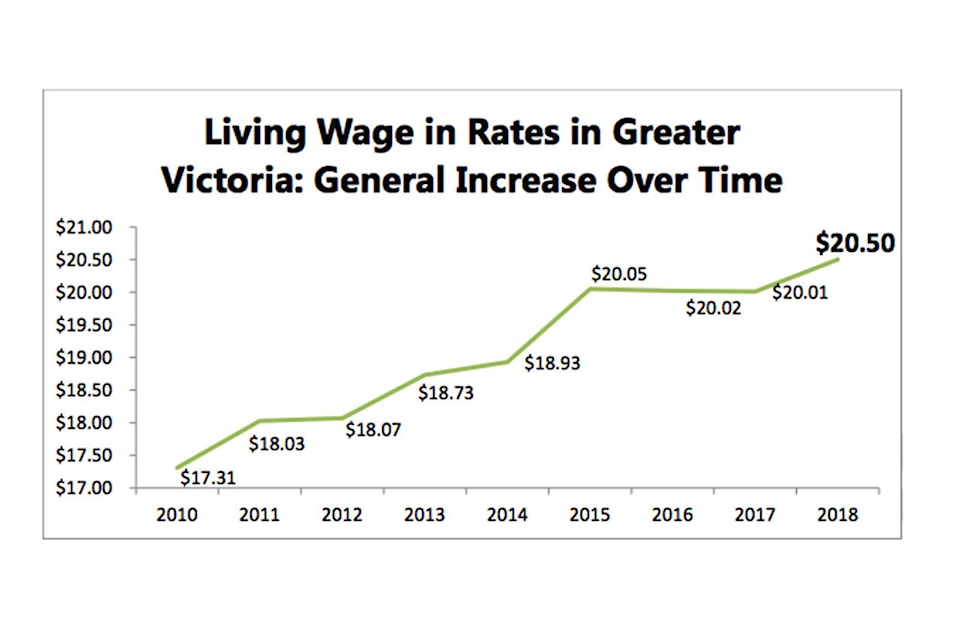If the average family of four had two parents earning $20.50 an hour full time in Victoria, at the end of the year they’d have enough savings to buy one latte.
This living wage estimate is calculated by the Community Social Planning Council of Greater Victoria, and uses a model of two full-time working parents with two children, aged seven and four, to calculate the minimum income required to meet the most basic needs.
With two people making $20.50 an hour, such a family could pay for basic shelter, clothing, food, transportation and medical expenses, as well as two weeks of sick leave.
Without any other income or outside help, they would not be able to afford to save for their children’s post-secondary education, their own retirement, to pay off debt or care for an elderly relative.
The council’s annual report, released last week, put the region’s living wage at $0.49 more than in 2017. The highest costs attributed to shelter and childcare, which made up more than 50 per cent of expenses. After all other costs were calculated, an average family would have $6.18 in savings by the end of the year.
Meanwhile, things are cheaper but still getting more expensive in the Comox Valley.
According to a report published by the Living Wage for Families Campaign, the Canadian Centre for Policy Alternatives’ BC office, and the First Call: BC Child and Youth Advocacy Coalition, the Comox Valley’s living wage is now considered to be $16.59 per hour.
That’s a 63-cent per hour increase from the 2017 report, which calculated the Valley’s living wage to be $15.96 per hour.
Roger Albert, a member of the Comox Valley Housing Task Force and the Comox Valley Social Planning Society (CVSPS), says the Valley’s inflation rate last year was nearly double the provincial average. (3.9 per cent annually in the Valley versus 2.2 per cent in B.C.).
“We know transportation has gone up, we know that food costs have gone up,” he said. “We know that in the last year, daycare went up, but daycare is going to go down because of the [provincial government’s] initiative to reduce the costs to parents by about $100 per month.”
“We need to see changes in government. We need to look at measures to increase the supply in affordable housing options and improve the costs of childcare,” said Community Social Planning Council of Greater Victoria research manager Stefanie Hardman. “They are the two largest expenses, and any measures that could help alleviate those would help parents struggling with a living wage.”
Recent changes announced in the provincial budget, such as a slash in MSP rates and the introduction of a Child Care Fee Reduction program are examples of social policies that could make a difference. However, the report notes that child care costs presently reach $15,210 per year for two children in care – including the $900 in savings from the fee reduction program.
“I think seeing how inadequate our minimum wage is, it’s really stark,” Hardman said. “We need to take further action and stronger initiatives to make this happen.”
Some employers combat poverty by joining the Living Wage Employer program, which guarantees their employees and contract staff the living wage of their region. However, without further changes in social policies, Hardman said, the living wage is only going to increase next year.
Albert hopes the new figures will encourage more businesses to become “living wage employers.”
“The living wage is a lot higher than the minimum wage here of $11.50 [per hour],” he said. “No wonder there are lots of help-wanted signs around in the food and other service industries. People making minimum wage can’t afford to live here.”
CVSPS chairwoman Bunny Shannon said she hopes community members will look at the report and learn from it. She feels the numbers justify the need for a universal guaranteed minimum income in B.C. or Canada.
“A lot of people in this community are living below the poverty line and a lot of them can’t afford homes,” she said. “And we’re not building homes that are affordable.”
According to the report, the highest living wage in B.C. continues to be in Metro Vancouver, at $20.91 per hour. This is a 30-cent per hour increase from 2017.
For more information on the report, visit livingwageforfamilies.ca.

